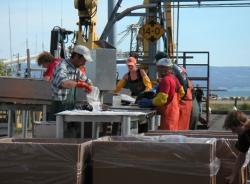The seafood industry in Alaska has two related, but very different sectors: Commercial fishing jobs and Seafood processing jobs. For seasonal employment you must choose usually, one or the other. Because the fishing industry is so very well established the methods in which fish are caught and then processed are very efficient. This has resulted in harvesting and processing typically being done independently of one another because of how different the two processes are. This way, more fish can be caught and processed than if every boat did both the catching as well as the processing of fish. There are some boats that do both harvesting and processing although this is slightly less common.
Harvesting is the act of catching the fish while processing is the method by which the fish are cleaned, gutted and frozen. Processing can take place on floating processing plants, (boats that are also processors) as well as in offshore processing plants. Processing is perhaps the easiest sector of the industry for new people to be hired. The training is usually very straightforward and there is an abundance of work to be done. Processing plants are the number one area in the Alaskan fishing industry where entry-level workers can find summer employment and year-round jobs. These people deal directly with the fish under what can include a large number of different jobs. Some of these jobs might be: cleaners, slimers, office workers, deck crew or clean-up crews. All of the positions are important and all of them represent good opportunities for seasonal seafood work. Often times, after a season as a processor you can find some of the more interesting and higher paying jobs because you’ve established yourself in the industry and have established contacts. These more specialized and higher paying jobs are often on the harvesting end, and can be difficult to obtain during your first season in Alaska.
Seafood Harvesting
Harvesters are also known as fishermen. They catch the different kinds of fish directly and are usually paid more than processors. They also work very different conditions, some of which are long, cold and strenuous. Not every position as a harvester is cold, long and wet, but the hours are certainly long and you can be sure that every penny made is a penny well earned as a harvester in Alaska. The boating hours can include days where workers are expected to perform for up to 18 hours, often in stressful conditions. One of the many reasons harvesters are paid more is because the risk is higher. Fishermen and deckhands are out on the open sea – a place that is very unpredictable and often times unsafe. While most boats have fishing seasons where no fatalities or serious injuries occur, each year a boat or two is lost at sea. It is for this reason that taking a job as a harvester, or one that requires you to be out at sea, should be taken only after serious consideration.
The different types of harvesting jobs depend on the type of boat a harvester works on. Therefore there are jobs on individual boats and jobs on large processing and catching boats. The smaller, individual boats don’t do any processing onboard and vary greatly in terms of how the ship is run as well as the jobs onboard. The larger vessels often catch and process fish on the same boat. This is usually because these large boats are commonly owned by big companies and the boat size can accommodate both a harvesting and processing crew at the same time. These large companies usually do their hiring from office headquarters, which is commonly outside of Alaska in seaport cities such as Seattle. This is an excellent example of why it is important to understand the industry so you can search for Alaskan fishing industry jobs in the correct locations and times of year.
It makes sense that harvesters would make more money than processors because of the skills and understanding required to work the ship. The additional physical requirements of a harvesting job also make the work more valuable and paychecks higher. For a salmon season, checks for deck hand can easily be in the upwards of $5,000 for a few months of work. Deck workers on crab, herring or longboats can make even more, making the deckhand job an excellent position for anyone willing to work hard and endure some physical discomfort. If you love the open sea, have big bucks in mind for your summer work season, a position as a deck hand could be for you. Set your Alaskan fishing industry sights on the Offshore Jobs!
Alaska Seafood Processing
Processing, while in general is less physically demanding than harvesting, is still nothing to scoff at. Because of the difference in work, processors tend to make less each year than harvesters. Processors do, however, make excellent seasonal salaries and represent the best opportunity for first timers in Alaska to make some money. The skills are less specialized and the jobs more plentiful for processors than for harvesters.
Processors can find themselves in a variety of positions, working both onshore and offshore. Canning, cleaning, gutting and freezing are all potential jobs of a fish processor in Alaska. The benefits of being a processor are in the number of hours you can work with little to no experience. A processor can make $6,000 in a season with overtime pay and a willingness to work. For processors who want to make money during the summer, the best job opportunities exist in shore based seafood processing plants. The jobs are simply in higher demand and much more abundant.


